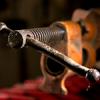I typically sand with 400 grit between finish coats but it is a long, boring process that I hate. (My favorite finish these days is minwax wipe-on poly diluted with a little mineral spirits and with a dash of tung oil added.) Does anyone have a magic finish recipe that provides a satin (NOT glossy) finish that doesn't require the hours of sanding? Should I try using an HVLP spray? I've been doing this for 30 years but surely there is some new finishing technology that provides a perfectly smooth finish sanding free.
Sanding the Greene and Greene crib I'm making takes hours between coats




 Reply With Quote
Reply With Quote









